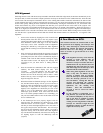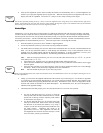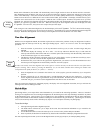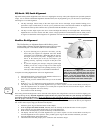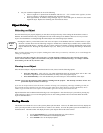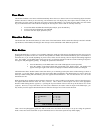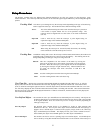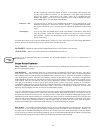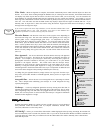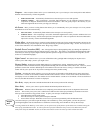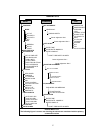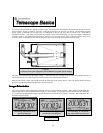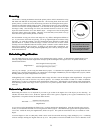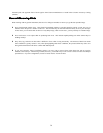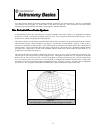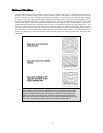
25
Filter Limits – When an alignment is complete, the NexStar automatically knows which celestial objects are above the
horizon. As a result, when scrolling through the database lists (or selecting the Tour function), the NexStar hand control
will display only those objects that are known to be above the horizon when you are observing. You can customize the
object database by selecting altitude limits that are appropriate for your location and situation. For example, if you are
observing from a mountainous location where the horizon is partially obscured, you can set your minimum altitude limit to
read +20º. This will make sure that the hand control only displays objects that are higher in altitude than 20º. If you
manually enter an object that is below the horizon using the numeric keypad, the hand control will display a warning
message before slewing to the object.
If you want to explore the entire object database, set the maximum altitude limit to 90º
and the minimum limit to –90º. This will display every object in the database lists
regardless of whether it is visible in the sky from your location.
Direction Buttons –The direction a star moves in the eyepiece varies depending on
the accessories being used. This can create confusion when guiding on a star using an
off-axis guider versus a straight through guide scope. To compensate for this, the
direction of the drive control keys can be changed. To reverse the button logic of the
hand control, press the MENU button and select Direction Buttons from the Utilities
menu. Use the Up/Down arrow keys (10) to select either the azimuth (left and right) or
altitude (up and down) button direction and press ENTER. Pressing ENTER again will
reverse the direction of the hand control buttons from their current state. Direction
Buttons will only change the eyepiece rates (rate 1-6) and will not affect the slew rates
(rate 7-9).
Goto Approach - lets the user define the direction that the telescope will approach
when slewing to an object. This allows the user the ability to minimize the effects of
backlash For example, if your telescope is back heavy from using heavy optical or
photographic accessories attached to the back, you would want to set your altitude
approach to the negative direction. This would ensure that the telescope always
approaches an object from the opposite direction as the load pulling on the scope.
Similarly, if using the NexStar polar aligned on a wedge, you would want to set the
azimuth approach to the direction that allows the scope to compensate for different load
level on the motors and gears when pointing in different parts of the sky.
To change the goto approach direction, simply choose Goto Approach from the Scope
Setup menu, select either Altitude or Azimuth approach, choose positive or negative and
press Enter.
Autoguide Rate – Allows the user to set an autoguide rate as a percentage of sidereal
rate. This is helpful when calibrating your telescope to a CCD autoguider for long
exposure photography.
Cordwrap - – Cord wrap safeguards against the telescope slewing more than 360º in
azimuth and wrapping accessory cables around the base of the telescope. This is useful
when autoguiding or any time that cables are plugged into the base of the telescope. By
default, the cord wrap feature is turned off when the telescope is aligned in altazimuth
and turn on when aligned on a wedge.
U
UU
U
U
UU
U
t
tt
t
t
tt
t
i
ii
i
i
ii
i
l
ll
l
l
ll
l
i
ii
i
i
ii
i
t
tt
t
t
tt
t
y
yy
y
y
yy
y
F
FF
F
F
FF
F
e
ee
e
e
ee
e
a
aa
a
a
aa
a
t
tt
t
t
tt
t
u
uu
u
u
uu
u
r
rr
r
r
rr
r
e
ee
e
e
ee
e
s
ss
s
s
ss
s
Scrolling through the MENU (9) options will also provide access to several advanced
utility functions within the NexStar such as; Compass Calibration, Periodic Error
Correction, Hibernate as well as many others.
GPS On/Off - Allows you to turn off the GPS module. When aligning the telescope using AutoAlign, the NexStar still
receives information, such as current time, from the GPS. If you want to use the NexStar database to find the coordinates of
a celestial object for a future date you would need to turn the GPS module off in order to manually enter a date and time
other than the present.
SETUP TIME-SITE
A
ZM POSITIV
E
A
ZM NEGATIVE
A
LT POSITIV
E
A
LT NEGATIVE
ANTI-BACKLASH
SLEW ALT MAX
SLEW ALT MI
N
SLEW LIMITS
A
LTMAX IN LIST
A
LTMIN IN LIS
T
FILTER LIMITS
DIRECTION BUTTONS
A
ZM APPROACH
A
LT APPROACH
GOTO APPROACH
A
ZM RAT
E
A
LT RAT
E
AUTOGUIDE RATES
CORDWRAP
SCOPE SETUP
GPS ON/OFF
FIND CELESTIAL NORTH
CALIBRATE COMPASS
COMPASS
MOVE ALT SENSOR
CALIBRATE SENSOR
ALT SENSOR
WEDGE ALIGN
PLAYBACK
RECORD
PEC
LIGHT CONTROL
PRESS UNDO
PRESS "0"
FACTORY SETTING
VERSION
GET ALT-AZ
GOTO ATL-AZ
HIBERNATE
UTILITIES
MENU
Observing
Tip!



